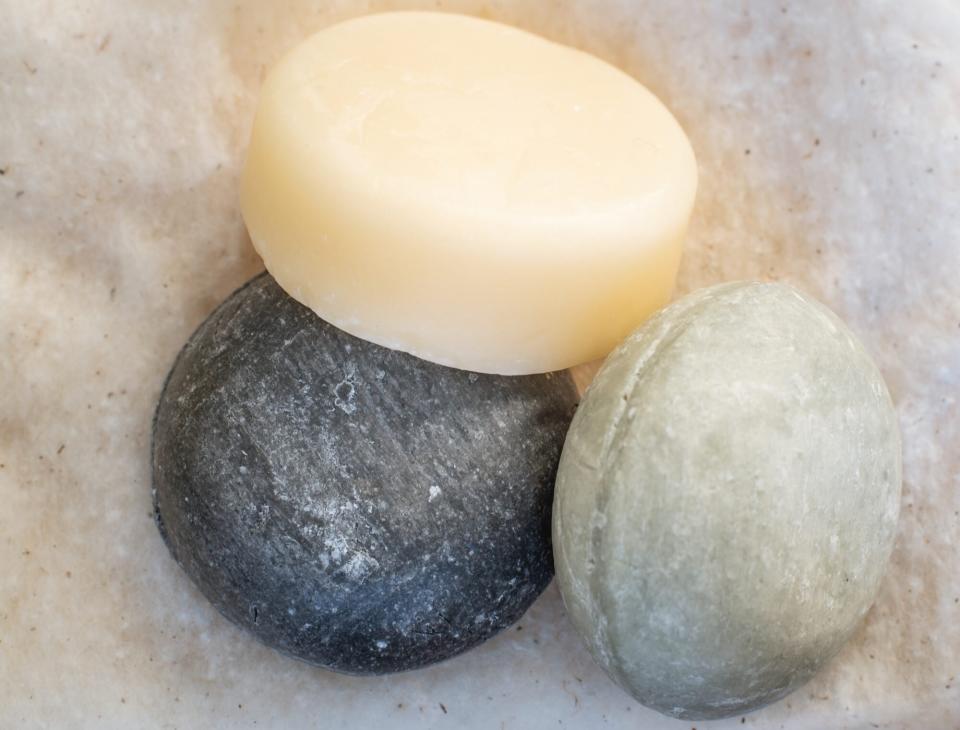What Is a Shampoo Bar? Plus, Find Out Why Your Hair Might Benefit from Using One
Refreshing your strands and scalp with shampoo is always the goal during your hair wash routine. And while you might already have a go-to hair cleanser, we'd urge you to consider one type that is often overlooked: shampoo bars. Here's what the experts say about this new hair care product category, including how to use these package-free bars effectively.
Related: How Often Should You Shampoo Based on Your Hair Type?
A shampoo bar is a solid version of your standard liquid option.
Think of your shampoo bar the same way you would your favorite liquid product. Luana Bumachar, the vice president of owned brands and innovation at Grove Collaborative, explains that these compact formulas are packed with the same active ingredients found in your bottled version—just condensed in small, solid form (usually with a nourishing base, like coconut oil). Plus, most shampoo bars are free of drying chemicals, parabens, phthalates, silicones, and SLS/SLEs. In turn, they are gentler on your scalp. "It is stripped of ingredients that only exist to make a shampoo liquid, such as water, while still providing all the benefits of a traditional shampoo in terms of specific hair needs, usage experience, and effectiveness," she adds.
Lather the shampoo either onto your scalp or in your hands.
Stephanie Louis, the chief executive, operating officer, and owner of Stylebox Salon, says to use a shampoo bar exactly like a bar of soap. The only difference? You'll lather this onto your scalp instead of your body. "If you have longer or curlier hair, we'd recommend rubbing the bar between your hands to work up a lather first, and once you have that soapiness, massage that directly onto your scalp," she says, explaining that this is helpful for kinkier textures, since rubbing a bar directly on the scalp can cause tangling. "Those with shorter, straighter hair can apply the product directly onto their head and scalp." Then, once you finish washing, rinse your hair clean per usual.
Depending on the shampoo bar brand, you may no longer need to use as much conditioner after washing. "Since some of the gentler, sulfate-free, and paraben-free cleansers don't strip the hair of its natural oils, they will leave the hair feeling softer, bouncier, and shinier than traditional detergent-based shampoos," adds Louis.

Marcela Vieira / Getty Images
Keep an eye out for any waxiness, though.
One thing to keep in mind when making the switch from liquid to bar shampoo? Your hair will need to adjust to the product. "Without getting too heavy on the science of saponification (the process that turns fats and oils into soap), one of the consequences of combining any soap bar with hard water is that it often causes soap scum," Louis says. "So, you could also experience that sticky, filmy, squeaky feeling from the soap scum residue remaining on your scalp." After a few washes, however, Bumachar says oil production should stabilize and build-up should clear, signaling that your hair and scalp are used to this new cleanser format.
These bars are long-lasting and environmentally friendly.
"One of the main benefits of using a shampoo bar over liquid shampoo is how much longer it lasts," Louis shares, noting that a little can really go a long way. The reason for this, explains Bumachar, is that most makers pack many concentrated, essential ingredients into the small bar. Another perk? Shampoo bars are eco-friendly, as they limit waste you would otherwise create with standard plastic shampoo bottles.
Related: Why Your Hair Needs a Beauty Routine, Too
There are a few main shampoo bar iterations available today.
While you can find a wide range of bars on the market, Louis explains that most fall into three categories: cold-pressed, glycerin-based, and surfactant. Cold-pressed iterations are made by mixing a fat (like shea butter) or an oil (like coconut oil) with an alkali (like lye), the hair expert shares. These rich varieties may lead to scalp build-up without a clarifying rinse, like one based with apple cider vinegar. Glycerin-based options can cause breakouts and weigh hair down from compounds like palm oil, but are oftentimes the most hydrating. Lastly, surfactant shampoo bars are like your traditional shampoos; they can work up a good lather, but can be drying, which is why Louis recommends using a conditioner afterwards.
The experts have a few favorites.
Overall, Louis recommends shampoo bars that steer clear of silicones, sulfates, and parabens. The Shea Moisture Coconut & Hibiscus Clay Shampoo Bar ($7.99, amazon.com) is one of her favorites for this very reason. Plus, it's perfect for those with thick, curly textures. Another top pick for a range of textures? The OBIA Naturals Coconut and Shea Shampoo Bar ($11.98, walmart.com), which prevents hair damage and scalp irritation and protects strands from heat and chemicals.
Use shampoo and conditioner bars together when possible.
Whenever possible, pair a brand's shampoo bar with the corresponding conditioner bar to "reinforce the benefit, and leave hair nourished and soft," Bumachar adds. As for her go-tos? She prefers scalp-specific options, which cater to hydration, moisture, and volume. The Peach Strengthening Shampoo and its conditioning counterpart ($22.95, grove.co), for example, are rich in monoi oil and "promote a healthy scalp, improve hair elasticity and strength, and reduce breakage and split-ends while smoothing the hair cuticle and reducing frizz."
Are your hair and scalp in need of moisture? Bumachar turns to the Peach Moisturizing Shampoo and Conditioner Bars ($22.95, grove.co). These feature nourishing babassu oil that restores the scalp and also locks in moisture and shine without weighing hair down. For those looking to boost volume, turn to "the Peach Volumizing Shampoo Bar and Conditioner ($22.95, grove.co), which have scalp-invigorating hibiscus oil to plump strands while improving blood circulation to the scalp, promoting keratin production, and amplifying hair for a fuller look from roots to tips," Bumachar notes.

